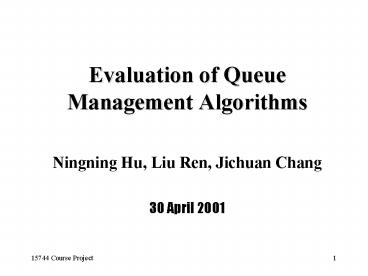Evaluation of Queue Management Algorithms - PowerPoint PPT Presentation
Title:
Evaluation of Queue Management Algorithms
Description:
15744 Course Project. 1. Evaluation of Queue Management Algorithms ... Freeze-time. Arrival. Computational. Overhead. Small. Large. Small. Small. Large. Buffer size ... – PowerPoint PPT presentation
Number of Views:47
Avg rating:3.0/5.0
Title: Evaluation of Queue Management Algorithms
1
Evaluation of Queue Management Algorithms
- Ningning Hu, Liu Ren, Jichuan Chang
- 30 April 2001
2
Motivation
- Typical queuing discipline DropTail
- Active queue management
- RED (93), BLUE (99),
- FRED (97), SFB (99), CHOKe (2000)
- Problem How to compare them?
- Metrics Utilization, Fairness and Complexity
- Method simulation under common settings
3
Algorithms
- Drop Tail drop when the queue is full
- RED queue length, minth, maxth, avg
- FRED per-active-flow accounting
- BLUE loss rate, link utilization, freeze_time
- SFB identify flows using N L bins
- CHOKe compare incoming packet with random
selected packet in queue
4
Simulation Scenario
source
destination
2Mbps
2Mbps
UDP
UDP
1Mbps, 40ms
router
router
TCP
TCP
- Topology Dumb-bell
- Metrics throughput and queue size
5
TCP
Drop Tail
RED
BLUE
TCP
FRED
SFB
CHOKe
- TCP Flow UDP Flow 10 1
- UDP sending rate 2Mbps
- Buffer size 150 packets
6
Performance Comparison
Figure 1. UDP Thpt (Mbps)
Figure 2. UDP Queue Size (packet)
7
Conclusion
Algorithm Link Utilization Fairness Ease of Configuration
RED Good Unfair Hard
BLUE Good Unfair Hard
FRED Good Fair Easy (adaptive)
SFB Good Fair Easy (non-adaptive)
CHOKe Good Fair Easy (adaptive)
Algorithm Buffer size requirement Per-flow State Information Computational Overhead
RED Large No Arrival
BLUE Small No Freeze-time
FRED Small Yes Arrival-departure
SFB Large No Freeze-time
CHOKe Small No Arrival
8
FRED
- RED Per-active-flow accounting
- protection of fragile flow
- penalizing non-responsive flow
- Flow type differentiation
- Key parameter minq
- 2 or 4
- Weak point
- Compute avgq per packet
9
FRED performance
10
FRED characteristics
- Easy to configure, adaptive
- Buffer size requirement
- Will degrade as DropTail with too many flows
- Two-packet-buffer to keep fairness
11
CHOKe
CHOose and Keep for responsive flows CHOose and
Kill for unresponsive flows
12
CHOKe
13
Parameters in CHOKe
14
BLUE
- Main Point Uses packet loss and link idle events
instead of average queue length - Based on observation that RED is often forced
into drop-tail mode - Adapt to how bursty and persistent congestion is
by looking at loss/idle events
15
BLUE Algorithm
- Pm is Blues packet dropping probability
- Upon packet loss, if no update of pm in
freeze_time then increase by d1 - Upon link idle, if no update of pm in freeze_time
then decrease pm by d2 - d1 gtgt d2 ?
- More critical to react quickly to increase in load
16
BLUE Characteristics
- More stable queue size and much better behavior
with small buffers - Good property damaged by non-responsive flows.
17
Stochastic Fair Blue(SFB)
- Objective
- Identify and penalize misbehaving flows
- Main Algorithm
- Create L hashes with N bins each
- Each bin keeps track of separate marking rate
(pm) - Rate is updated using standard technique(as BLUE)
- Flow uses minimum pm of all L bins it belongs to
- Non-misbehaving flows hopefully belong to at
least one bin without a bad flow
18
SFB Characteristics
- Could effectively detect non-responsive flows and
rate-limit them - But not adaptive, the bandwidth share of
non-responsive flows is controlled by a
parameter(Boxtime) offered by the user. - Boxtime is the time interval no packets from
non-responsive flows can be enqueued.
19
SFB Unfairness of Non-responsive Flows
Our solution Randomized Boxtime a little bit.
20
Rate-limit Non-responsive flows
UDP packets
Boxtime
Queue
Time































